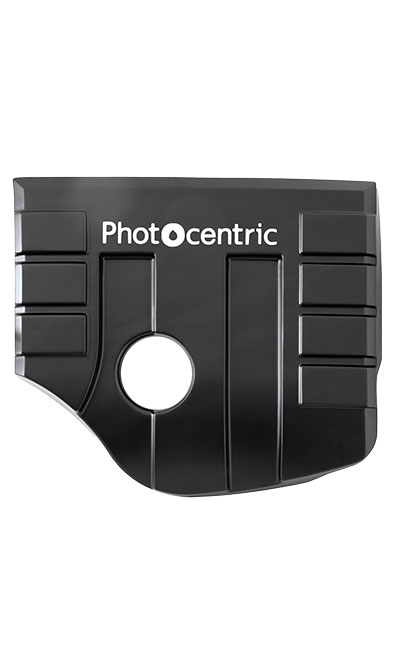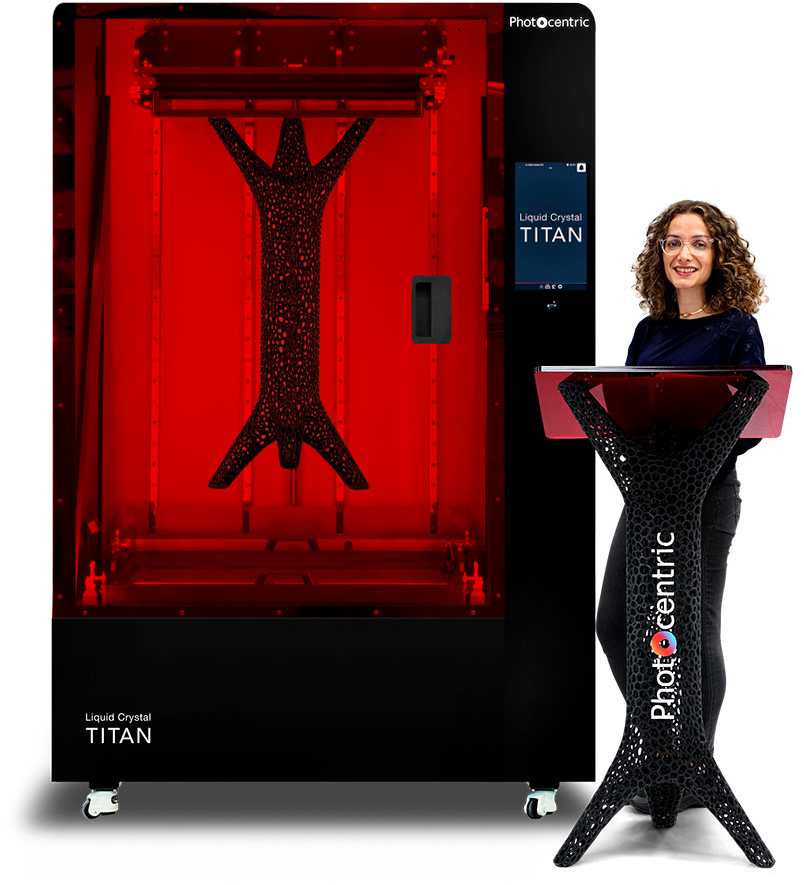Liquid Crystal Titan
The largest LCD 3D printer
in the world
A complete manufacturing solution
See how Titan can transform your business by requesting a free Total Cost of Ownership for your part, unlike most companies this is comprehensive with full disclosure
Printer
Specifications
Extrem großes Druckvolumen
695 x 385 x 1200mm
27,3 x 15,2 x 47,2″
Hochauflösender Pixelabstand
91μm pixel pitch delivering outstanding surface finish
≤ 86mm/hr print speed
At 350μm layers volumetric speed = 24 ltr/hr
Auswechselbare Plattform mit ResinGlide-Beschichtung
Easy cleaning with less waste
Patentierte Blow-Peel-Technologie
Ensures reliable, fast printing
Fernsteuerung und -überwachung
4k time-lapse cameras
Automatische Harzkontrolle
Auto vat fill and empty functions
Complete Printing Ecosystem

Software
Prepare files using Photocentric Studio or VoxelDance Additive; both perpetual licences are included at no cost
VoxelDance provides incredible flexibility, easily managing large files (>1GB) while also offering automatic supports
Upload file remotely through web UI or USB
Preloaded Titan print profiles
Drucker
Intuitive & user friendly
Reliable process with peel release technology
Automated resin control
Remote inspection
Remote control
Interactive GUI
Factory calibrated platform
Accessories for finishing printed parts and maintaining system
Handler
Open print door, insert purpose-built platform handler
Remove platform with part
Transfer between print, wash, cure and finishing station
Wash XL
All in one, wash, rinse and dry processing unit
Manually direct sprays of resin cleaner to all parts while platform is rotated with auto or manual control
Separate water rinse system
Air gun to dry parts
Cure XL
Load into cure unit
Full cure with dual wavelength 365 & 405nm and heat
360°rotating platform
360°rotating lower glass turntable for off-platform parts
Remove platform and remove parts
Services offered
DFAM
- Design for Additive Manufacturing consultancy
- Evaluate your part and assess its suitability for printing
- Propose design changes to reduce cost and improve printability
TCO
- Total Cost of Ownership (TCO) on your part, just supply your stl and the quantity
- Complete cost of manufacture, from part design to disposal of waste with payback
Service-Pläne
- 3 comprehensive service plans, Standard, Premium and Elite
- Including installation, training and maintenance
- Providing all options from budget support through to concierge service
Ausbildung
- Email and telephone support
- Online software support training in how to design for additive manufacturing
- Training in optimising the printing process
Carbon Footprint
- Carbon Footprint Analysis offered with all resins
- Embedded Carbon Calculator of each part taking your intake feeds
Maßgeschneiderte Wasch- und Trocknungseinheiten
Photocentric Waschen XL
Three in one. Wash, rinse and dry
Photocentric Wash XL is purpose-built to effectively clean large complex parts printed on Liquid Crystal Titan, combining wash, rinse and dry functions in a single compact unit.
360°-Drehung der Plattform
Adjustable speed to access all surfaces
Umweltschonend
Recyclingmöglichkeit für gebrauchte
Photocentric Harzreiniger 30
Intelligentes Flüssigkeitsmanagement
Für Wasser- und Harzreinigerdurchfluss
Multi-directional adjustable nozzles
Efficient spray cleaning of complex large parts
Push fit easy
clip platform
Easy transfer between printer, wash and cure units
Innenbeleuchtung, Sichtfenster und Scheibenwischer
Interactive user interface and ergonomic design
Photocentric Heilung XL
Cure large parts with heat and dual wavelength light
Photocentric Cure XL is designed to cure parts printed on Liquid Crystal Titan. Cure XL provides uniform post-curing with dual wavelength light and evenly distributed heat with 360° platform rotation, resulting in dimensionally accurate tack-free parts.
Zwei Wellenlängen
365 & 405nm
Optimised evenly distributed dual wavelength light
Heating function up to 60°C (140°F)
Evenly distributed with smart fume extraction and inspection window
Adjustable speed 360° platform rotation
Curing on-platform parts evenly
Interactive user
interface
Optimised part-dependent curing process
360° rotating lower
glass turntable
Cure off-platform parts evenly
Push fit easy clip
platform
Easy transfer between printer, wash and cure units
Maßgeschneiderte Wasch- und Trocknungseinheiten
Photocentric Waschen XL
Three in one. Wash, rinse and dry
Photocentric Wash XL is purpose-built to effectively clean large complex parts printed on Liquid Crystal Titan, combining wash, rinse and dry functions in a single compact unit

360°-Drehung der Plattform
Adjustable speed to access all surfaces
Umweltschonend
Recycling-Option für gebrauchte Photocentric Harz-Reiniger 30
Intelligentes Flüssigkeitsmanagement
Für Wasser- und Harzreinigerdurchfluss
Multi-directional adjustable nozzles
Efficient spray cleaning of complex large parts
Push fit easy clip platform
Easy transfer between printer, wash and cure units
Innenbeleuchtung, Sichtfenster und Scheibenwischer
Interactive user interface and ergonomic design
Photocentric Heilung XL
Cure large parts with heat and dual wavelength light
Photocentric Cure XL is designed to cure parts printed on Liquid Crystal Titan. Cure XL provides uniform post-curing with dual wavelength light and evenly distributed heat with 360° platform rotation, resulting in dimensionally accurate tack-free parts.

Zwei Wellenlängen
365 und 405nm
Optimised evenly distributed dual wavelength light
Heating function up to 60°C (140°F)
Evenly distributed with smart fume extraction and inspection window
360° rotating lower glass turntable
Cure off-platform parts evenly
Adjustable speed 360° platform rotation
Curing on-platform parts evenly
Push fit easy clip platform
Easy transfer between printer, wash and cure units
Interaktive Benutzeroberfläche
Optimised part-dependent curing process
Titan advantages
Titan creates the largest, highest resolution parts, most rapidly and cost effectively
Wide range of resins; tough, hard, investment casting and elastomeric
Creates massive stunning parts

Part making support and Titan Service
We pride ourselves on our customer service and guarantee you print successfully. We have the most experience of printing with LCD screens of any company. All Titan customers can access this knowledge. We will orientate and support your part for you using the latest Voxel Dance software and give you advice on how to make your part most efficiently.
Costing print examples
Lattice
Print time: 48 hrs | Dimensions: 120 x 70 x 40 cm

Brain
Print time: 24 hrs | Dimensions 30 x 20 x 20 cm

Laufender Mann
Print time: 60 hrs | Dimensions: 170 x 220 x 50 cm
Rednerpult
Print time: 60 hrs | Dimensions: 155 x 50 x 40 cm

Motorabdeckung
Print time: 32 hrs | Dimensions 60 x 60 x 10 cm

Lampenschirm
Print time: 29 hrs | Dimensions 60 x 40 x 40 cm
Neptun
Print time: 130 hrs | Dimensions: 220 x 110 x 70 cm
Genie
Print time: 65 hrs | Dimensions: 160 x 90 x 90 cm
Heilt den gesamten Baubereich gleichzeitig
Order of magnitude more curing ability than lasers.
Cures the entire platform not single pixels, individual control of over 33 million pixels. At 100 μm over 300 quadrillion addressable voxels
Energieeffizienter 3D-Druck
Lowest CO2 plastic printing process
We can supply a Carbon Footprint for your part
Heilt den gesamten Baubereich gleichzeitig
Order of magnitude more curing ability than lasers.
Cures the entire platform not single pixels, individual control of over 33 million pixels. At 100 μm over 300 quadrillion addressable voxels
Energieeffizienter 3D-Druck
Lowest CO2 plastic printing process
We can supply a Carbon Footprint for your part
Drucker-Spezifikationen
Tageslicht-Technologie
Wellenlänge des Lichtausgangs 460nm
Volumen aufbauen
695 x 385 x 1200mm
27.3(w) x 15.2(d) x 47.2(h)″
Schichtdicke
50-350µm
Pixelabstand
91μm | 3.6 thou
LCD-Bildschirm
32″ 8K 7680 x 4320 px
Druckgeschwindigkeit
86mm | 3.4″ per hour at 350µm
13″ Touchscreen
Integriertes Kontrollsystem
Software
Photocentric Studio & Voxel Dance Additive included
Materialien
Tageslicht, BASF Ultracur3D®
Autofill-System für Harze
Power Input
32A 230v Single Phase
Abmessungen des Druckers
1544(w) x 926(d) x 2137(h) mm
60.8(w) x 36.5(d) x84.1(h)”
Konnektivität
Wi-Fi, Ethernet, USB 3.0
Wash XL Spezifikationen
Äußere Abmessungen
170 x 130 x 225cm (BxTxH)
66.9 x 52.2 x 88.8″
Aktives Volumen Abmessungen
90 x 90 x 135cm (BxTxH)
35.4 x 35.4 x 53.1″
Gewicht
500kg
1100lbs
Kompatibilität der Harze
Tageslicht & UV-Harze
Kompatibilität der Waschlösung
Photocentric Harz-Reiniger
Maximales Teilegewicht
35kg
77lbs
Reinigungsmethode
Manuelles Sprühen
Power Input
32A Single Phase 230V
Empfohlene Betriebstemperatur
10°C bis 40°C
500°F to 1040°F
Enthaltenes Zubehör
Wasserrohre, Luftrohre und Anschlüsse; 2 kundenspezifische IBC-Kappen mit Füllstandssensor, Stromkabel
Garantie 12 Monate
Druckluftbedarf - mindestens 6 bar (87psi)
Cure XL Spezifikationen
Äußere Abmessungen
170 x 170 x 225cm (BxTxH)
66.9 x 66.9 x 88.8″
Aktives Volumen Abmessungen
90 x 90 x 135cm (BxTxH)
35.4 x 35.4 x 53.1″
Gewicht
800kg
1760lbs
Kompatibilität der Harze
Tageslicht & UV-Harze
LED
Zwei Wellenlängen 365 & 405nm
Maximales Teilegewicht
35kg
77lbs
Power Input
32A Three Phase (415V)
Maximale Temperatur
Adjustable up to 60°C (140°F)
Enthaltenes Zubehör
Netzkabel
Garantie 12 Monate
Drehbarer runder Glastisch 900mm Durchmesser
Neptun
Details drucken:
Print time: 130 hrs (3 prints)
Resolution: 250µm
Resin: Titan Black 21.5kg
Height: 215cm
Width: 105cm
Depth: 70cm
Aufschlüsselung der Kosten
Optional maintenance is available
Neptun entworfen von www.sanix3d.com

Lattice
Details drucken:
Print time: 60 hrs
Resolution: 250µm
Resin used: Titan Hard Black 2.6kg
Height: 155cm
Width: 50cm
Depth: 40cm
Aufschlüsselung der Kosten
Optional maintenance is available

Rednerpult
Details drucken:
Print time: 48 hrs
Resolution: 250µm
Resin used: Titan Hard Black 22kg
Height: 120cm
Width: 70cm
Depth: 40cm
Aufschlüsselung der Kosten
Optional maintenance is available

Brain
Details drucken:
Print time: 24 hrs
Resolution: 250µm
Resin used: 2.1kg
Height: 30cm
Width: 20cm
Depth: 20cm
Aufschlüsselung der Kosten
Optional maintenance is available

Motorabdeckung
Details drucken:
Print time: 32 hrs
Resolution: 250µm
Resin used: Titan Hard Black 2.6kg
Height: 60cm
Width: 60cm
Depth: 10cm
Aufschlüsselung der Kosten
Optional maintenance is available

Laufender Mann
Details drucken:
Print time: 60 hrs
Resolution: 250µm
Resin used: Titan Hard Black 2.9kg
Height: 170cm
Width: 220cm
Depth: 50cm
Aufschlüsselung der Kosten
Optional maintenance is available

Lampenschirm
Details drucken:
Print time: 29 hrs
Resolution: 250µm
Resin used: Titan Hard Black 2.3kg
Height: 60cm
Width: 40cm
Depth: 40cm
Aufschlüsselung der Kosten
Optional maintenance is available

Genie
Details drucken:
Print time: 65 hrs
Resolution: 250µm
Resin used: Titan Hard Black 22kg
Height: 160cm
Width: 90cm
Depth: 90cm
Aufschlüsselung der Kosten
Optional maintenance is available








